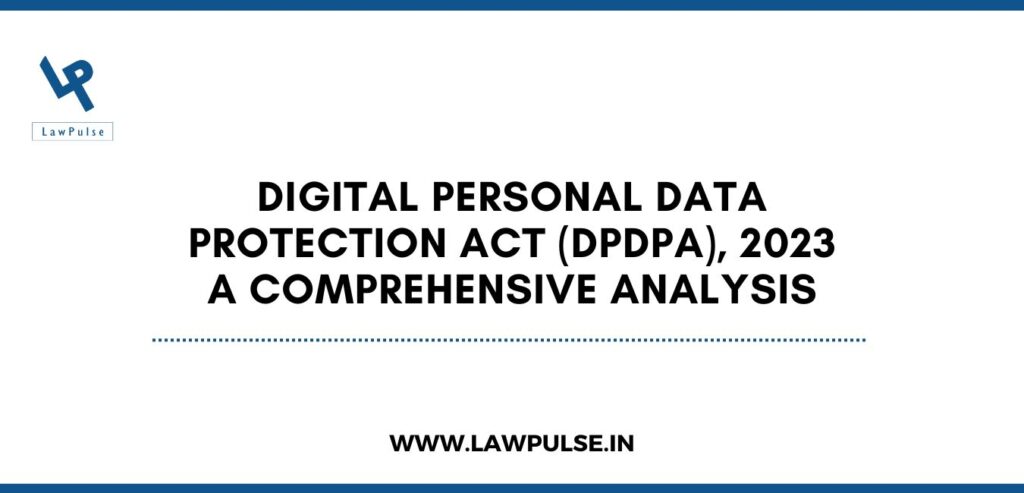DIGITAL PERSONAL DATA PROTECTION ACT (DPDPA) 2023 A COMPREHE
Akshat Khandelwal
September 27, 2023
Blogs

Navigating Data’s New Frontier
In the rapidly evolving digital landscape, data has emerged as the new currency, fueling innovation, economic growth, and enhanced user experiences. However, this digital transformation has also brought to the forefront critical concerns about data privacy, security, and individual rights. Recognizing the need for a robust regulatory framework, the Indian government introduced the Digital Personal Data Protection Act (DPDPA) in 2023, a landmark legislation aimed at governing the processing, storage, and protection of personal data. This article undertakes an in-depth exploration of the key provisions, implications, and potential challenges of the DPDPA, while also drawing parallels and contrasts with the General Data Protection Regulation (GDPR) of the European Union.
A Paradigm Shift in Data Privacy:
At the core of the DPDPA lies a paradigm shift in the understanding of data privacy. Traditionally, privacy has been associated with physical spaces, but the DPDPA acknowledges that privacy extends to the digital realm as well. This recognition is aligned with the Indian Supreme Court’s landmark decision in K S Puttaswamy v Union of India (2017), which upheld that an individual’s privacy is not relinquished even in public spaces. By extending the right to privacy to the digital arena, the DPDPA sets a precedent that resonates with global privacy norms.
The Complex Conundrum of Publicly Available Data:
One of the intriguing aspects of the DPDPA is its treatment of publicly available personal data. While conventional wisdom dictates that individuals retain privacy rights even in public spaces, the DPDPA introduces an exemption for personal data shared by individuals in the public domain. This exemption, while recognizing the realities of data sharing, raises complex questions about the interplay between data availability and data protection. The challenge lies in striking the right balance between safeguarding privacy and facilitating data-driven innovation.
Governmental Information-Sharing Powers:
Another dimension of the DPDPA is the governmental authority to request information from the Data Protection Board and digital service providers for the purposes of the Act. Unlike some laws that outline specific purposes for information sharing or delegate this power to independent regulatory bodies, the DPDPA’s provision lacks such delineation. This sweeping power opens up a range of concerns, including data security, citizen privacy, and potential misuse of information. The delicate task lies in finding a harmonious equilibrium between governmental authority and the imperative of data protection.
Balancing Enforcement and Fundamental Rights:
A noteworthy provision of the DPDPA is its authorization for blocking access to digital services under certain circumstances. In cases where the Data Protection Board imposes monetary penalties on a digital service multiple times, the Board can recommend the government to block access in the public interest. While this provision aligns with the government’s existing power to block websites and online services under the Information Technology Act, it raises questions about its implications for online free expression and fundamental rights. Striking the right balance between regulatory enforcement and individual rights is a tightrope walk.
Navigating Algorithmic Transparency:
Both the DPDPA and the GDPR underscore the accountability of data controllers and processors. However, in the realm of algorithmic decision-making, achieving transparency poses a significant challenge. The proliferation of complex algorithms and automated processes means that individuals often lack insight into how their data is used to make decisions that affect them. This challenge requires nuanced solutions that balance the need for transparency with the protection of proprietary algorithms, thereby ensuring that accountability remains a cornerstone of data protection efforts.
Enforcement in the Digital Age:
The efficacy of data protection laws hinges on robust enforcement mechanisms and meaningful penalties. Similar to the GDPR, the DPDPA introduces substantial fines for non-compliance. However, the true impact of these penalties will emerge as regulatory bodies levy fines and enforce compliance. To ensure the effectiveness of these laws, enforcement mechanisms must evolve to address emerging challenges, data breaches, and evolving privacy concerns. The ability to adapt to technological advancements will be a litmus test for the legislation’s effectiveness.
Challenges and Lacunae:
Despite their comprehensive frameworks, both the DPDPA and GDPR grapple with challenges and gaps. India’s DPDPA introduces an exemption for publicly available personal data, raising questions about the boundary between privacy and innovation. The broad government information-sharing powers under the DPDPA necessitate clearer boundaries to avoid misuse. On the other hand, GDPR implementation discrepancies across EU member states and the debate over proportionality of penalties highlight areas of concern.
Moreover, emerging technologies like artificial intelligence (AI), machine learning, and the Internet of Things (IoT) reshape industries, posing new challenges to data protection. Both the DPDPA and GDPR need to adapt to the complexities of these technologies. AI, for instance, heavily relies on data processing, which can raise concerns about automated decision-making and algorithmic bias. Ensuring that these technologies are harnessed responsibly and ethically while respecting individual privacy rights necessitates continuous legislative updates and adaptability.
Furthermore, the issue of data localization and data sovereignty presents a complex interplay between data protection and national interests. Several countries, including India, have considered or implemented data localization measures to ensure that personal data of their citizens is stored within their borders. While this may enhance data security and control, it also raises concerns about the global flow of information and the potential stifling of cross-border data flows. Both the DPDPA and GDPR need to strike a delicate balance between data protection and the facilitation of global data exchanges.
Recent Post
-
 04 Apr 2024National Trial Advocacy Competition by Amity University Rajasthan | April 25th – 26th, 2024 [Register by April 9, 2024]
04 Apr 2024National Trial Advocacy Competition by Amity University Rajasthan | April 25th – 26th, 2024 [Register by April 9, 2024] -
 13 Feb 2024Understanding India's Minimum Support Price (MSP) System
13 Feb 2024Understanding India's Minimum Support Price (MSP) System -
 07 Feb 2024CFP: ODR POLICY SUMMIT 2024 ORGANISED BY SGT UNIVERSITY, GURUGRAM: [HYBRID, MARCH 16TH ] [REGISTER BY 15TH FEB, 2024]
07 Feb 2024CFP: ODR POLICY SUMMIT 2024 ORGANISED BY SGT UNIVERSITY, GURUGRAM: [HYBRID, MARCH 16TH ] [REGISTER BY 15TH FEB, 2024]
Get Notified Every Time We Post An New Episode
Other Pages
Copyright © Law Pulse 2023. All rights reserved.



